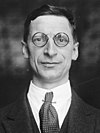Government of the 7th Dáil
6th executive council of the Irish Free State | |
|---|---|
| Executive Council of the Irish Free State | |
 | |
| Date formed | 9 March 1932 |
| Date dissolved | 8 February 1933 |
| People and organisations | |
| King | George V |
| Governor-General |
|
| President of the Executive Council | Éamon de Valera |
| Vice-President of the Executive Council | Seán T. O'Kelly |
| Total no. of members | 10 |
| Member party | Fianna Fáil |
| Status in legislature | Minority Government |
| Opposition party | Cumann na nGaedheal |
| Opposition leader | W. T. Cosgrave |
| History | |
| Election | 1932 general election |
| Legislature terms | |
| Predecessor | 5th executive council |
| Successor | 7th executive council |
The 6th executive council of the Irish Free State (9 March 1932 – 8 February 1933) was formed after the 1932 general election to the 7th Dáil held on 16 February. It was led by Fianna Fáil leader Éamon de Valera as President of the Executive Council, taking office after ten years of government led by W. T. Cosgrave of Cumann na nGaedheal. De Valera had previously served as President of Dáil Éireann, or President of the Republic, from April 1919 to January 1922 during the revolutionary period of the Irish Republic. It lasted for 336 days.
Nomination of President of the Executive Council
[edit]The 7th Dáil first met on 9 March 1932. In the debate on the nomination of the President of the Executive Council, Fianna Fáil leader Éamon de Valera was proposed, and the motion was approved by 81 votes to 68.[1] The Labour Party supported the nomination of de Valera and the formation of the executive council, but did not form part of the government. He was then appointed as president by Governor-General James McNeill.
| 9 March 1932 Nomination of Éamon de Valera (FF) as President of the Executive Council[2] Motion proposed by Michael Kilroy and seconded by Oscar Traynor Absolute majority: 77/153 | ||
| Vote | Parties | Votes |
|---|---|---|
| Fianna Fáil (71), Labour Party (7), Independents (3) | 81 / 153
| |
| No | Cumann na nGaedheal (55), Farmers' Party (2), Independents (11) | 68 / 153
|
| Absent or Not voting |
Cumann na nGaedheal (1), Independent (1), Ceann Comhairle (1) | 3 / 153
|
| Vacant | 1[3] | 1 / 153
|
Members of the Executive Council
[edit]The members of the Executive Council were proposed by the president and approved by the Dáil.[4] They were then appointed by the Governor-General.[5]
Parliamentary secretaries
[edit]On 10 March 1932, the Executive Council appointed Parliamentary secretaries on the nomination of the President.[6][7]
Footnotes
[edit]- ^ Connolly was appointed as Minister for Posts and Telegraphs while a member of Seanad Éireann, and became the first person to be a Minister while not a member of Dáil Éireann.
References
[edit]- ^ "Nomination of President of the Executive Council – Dáil Éireann (7th Dáil)". Houses of the Oireachtas. 9 March 1932. Retrieved 23 August 2019.
- ^ "Nomination of President of the Executive Council – Votes – Dáil Éireann (7th Dáil)". Houses of the Oireachtas. 9 March 1932. Retrieved 7 March 2020.
- ^ "Death of Former Members of Dáil – Dáil Éireann (7th Dáil)". Houses of the Oireachtas. 9 March 1932. Retrieved 7 March 2020.
- ^ "Nomination of Executive Council – Dáil Éireann (7th Dáil)". Houses of the Oireachtas. 9 March 1932. Retrieved 22 August 2019.
- ^ "Appointment of Executive Council – Dáil Éireann (7th Dáil)". Houses of the Oireachtas. 15 March 1932. Retrieved 7 March 2020.
- ^ "Appointment of Parliamentary Secretaries – Dáil Éireann (7th Dáil)". Houses of the Oireachtas. 15 March 1932. Retrieved 14 December 2019.
- ^ "History of Government – Seventh Dáil – Parliamentary Secretaries". Government of Ireland. 27 November 2018. Retrieved 7 January 2021.
- ^ "Appointment of Parliamentary Secretary – Dáil Éireann (7th Dáil)". Houses of the Oireachtas. 9 November 1932. Retrieved 7 January 2021.
